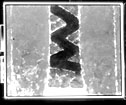|

Comment
on this story
What:
H.A. Sigg: Recent Work
Where:
UT's Ewing Gallery of Art and Architecture, 1715 Volunteer Blvd.
When:
Through Sept. 15.
Lecture by curator Margaret Mathews-Berenson on Thursday, Sept. 12 at 7 p.m. Reception in room 109 of the Art/Architecture Bldg., following the lecture.
Call 974-3200 for information or visit their website.
|
|

Does artist Hermann Alfred Sigg offer too little, too late?
by Heather Joyner
Given the negative tenor of a few of my recent reviews, some readers might think I've hopped on the slam wagon when it comes to local exhibits. Yes, this summer's been muggy, mosquito-ridden, and otherwise less than comfortable, but in any season, surrendering my mind to things visually captivating generally puts me in a mood to lavish praise. Trouble is, art I've seen in weeks past has made captivation difficult—the equivalent of trying to enjoy walking with bubblegum stuck to one's sandal. And for me, the Ewing Gallery's current show of art by Hermann Alfred Sigg has been no less sticky.
H. A. Sigg: Recent Work consists of large abstract canvases, more than a dozen collages, and a number of found-object sculptures perched on pedestals. Curated by Margaret Mathews-Berenson (an arts administrator credited with "discovering" Sigg's work in the early '90s), the show includes paintings from two series: "In the Land of the River" and "In the Middle Realm." Although it's refreshing to see abstract expressionist art with titles beyond the usual untitled-number-whatever labels, those mystical phrases hint at work more fanciful than Sigg's is. In painting, Sigg—a grown version of the responsible Swiss farm lad he once was—has latched onto a few themes and stuck with them through thick and thin pigment. His pieces often feature a pictographic squiggle, be it between slab-like rectangles, on a field of blue, or within a number of vertical bands. Clearly, this fellow is certain about what he's up to.
So what is wrong with an artist having a guiding theme or two? First, there's the possibility of running them into the ground—no pun intended. Yet the color field paintings of Rothko (to whom Sigg has oft been compared) are like visual sonnets—the form remains constant but the contents can be drastically different. It is also difficult to find themes that are universal but not cliché. The theme—if you can call it that—of jaunty cut-out compositions by Matisse (to whom Sigg has also been compared) is one of pure visual play, no strings attached. And despite their connection to work by Jean (Hans) Arp, Matisse's cut-outs are identifiably his. Creating the presence that large-scale canvases must possess is another issue, and the size forms assume should feel inevitable. Smaller versions of themes explored by Motherwell (yet another to whom Sigg has been compared) seem crammed together and stunted; expansiveness is evidently vital to Motherwell's brand of freedom.
It is an effort fraught with peril, this painting business. Beyond discovering which mediums and forms best suit their objectives, artists must nurture spontaneity and originality. That Sigg is compared to so many other artists could be due in part to when he entered the scene. Born in Oberhasli, Switzerland in 1924, he came of age during a dynamic period in art and was steeped in post-Impressionist and Modernist sensibilities. He studied with the Bauhaus oddball/genius Johannes Itten in Zurich and lived in Paris. Like some other artists, he was chastised for heading in a questionable direction. In fact, the severing of Sigg's ties with his father (who could not accept his preference for making art over farming land) has been a defining influence. Whatever the motivation or consequences, he was called "a traitor of holy ground" and tagged a rebel. At the same time, Sigg is very cautious in his work. It's as if he's still trying to convince his now-deceased father that his choice of careers is a solid one.
Similarities between Sigg's art and art by other individuals reflect that caution and perhaps a need to be legitimized by more established fare. His collage-oriented process was developed decades earlier by another man at home in Zurich: Arp. Following in Arp's footsteps, Sigg has moved from realism to something more minimal and has experimented with sculpture. Even if he isn't terribly original, Sigg could be a master of color or gesture. In my mind, he is not. But he is lucky.
Beginning in the 1960s, Sigg was commissioned to create murals and stained-glass art for institutions throughout Switzerland. After selling a number of paintings to Swissair, Sigg became that company's "artist-in-residence in the sky", and he was granted unlimited mileage and access to the cockpit. His travels to Asia, the Middle East, South America, and elsewhere have proved inspiring—especially views of the landscape and places like Cambodia's Angkor Wat from on high. The eight exhibited sculptures were created after a trip to China, and however witty, they do not differ much more from one another than do Sigg's paintings.
My reservations about Sigg's pieces have more to do with their cautious hesitation than their links to any particular impetus. The wood and metal sculptures, some of which look quite menacing, are very frontal. Sort of like clocks meant to face outward from a mantel. Sigg's brush strokes feel self-conscious and are painfully dry-looking. Everything seems confined to its own space, and the whiteness of primed canvas serves to predictably divide space. Looking at bold blocks of color that don't come together is like kissing someone through plate glass—one gets the message, but not the real sensation.
I can't help but wonder why Sigg never deviates from whatever approach he's settled on. Apparently, he's satisfied. His work is as sweet as chocolate, as hefty as a gold ingot, and as reliable as a fine watch, and for some viewers, I suppose that's enough.

August 22, 2002 * Vol. 12, No. 34
© 2002 Metro Pulse
|





